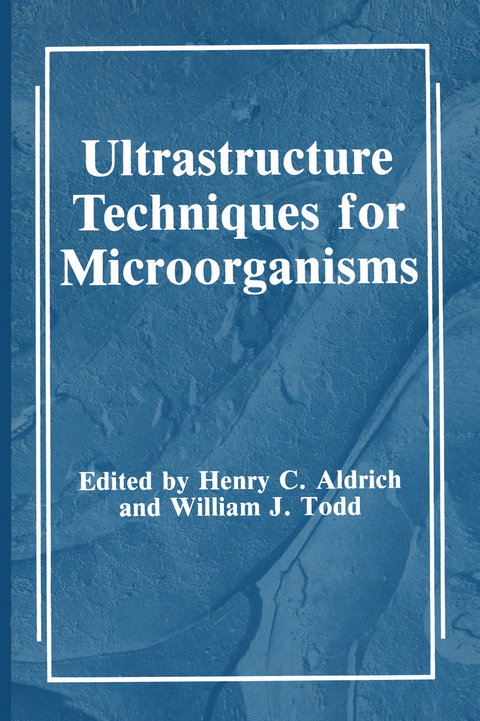
Ultrastructure Techniques for Microorganisms
Springer-Verlag New York Inc.
978-1-4684-5121-4 (ISBN)
1 Preparation of Microfungi for Scanning Electron Microscopy.- 1. Introduction.- 2. Microfungi in Pure Culture.- 3. Fungus-Natural Substrate Associations.- 4. Correlation of Morphological Data.- 5. Limitations of Preparatory Procedures.- 6. References.- 2 Low-Temperature Scanning Electron Microscopy.- 1. Introduction.- 2. Historical Review.- 3. The Apparatus and Methods Used.- 4. A Comparative Evaluation of the Technique.- 5. The Value and Importance of the Technique.- 6. Conclusions.- 7. References.- 3 Effects of Specimen Preparation on the Apparent Ultrastructure of Microorganisms.- 1. Specimen Preparation for Examination of Thin Sections.- 2. Fixation Additives to Improve Detection of Microbial Structures 903..- 3. Mesosomes and Fixation.- 4. Images of Gonococcal Pili.- 5. References.- 4 Secrets of Successful Embedding, Sectioning, and Imaging.- 1. Introduction.- 2. Historical Aspects.- 3. Fixation.- 4. Shrinkage.- 5. Flat Embedment for Light Microscope Selection of Cells.- 6. Other Embedding Tricks.- 7. Microtomy.- 8. Stability of Epoxy Resins.- 9. Tissue and Section Contaminants.- 10. Resin Modifiers for Improving Sectioning.- 11. Image.- 12. Evaluation of Diamond Knives.- 13. Safety.- 14. Appendix: Suggested Reading.- 15. References.- 5 Computer-Aided Reconstruction of Serial Sections.- 1. Introduction.- 2. Literature Review.- 3. Serial Sectioning.- 4. Obtaining the Ultrastructural Data for Computer-Aided Reconstruction.- 5. Entry of Ultrastructural Data into the Computer System.- 6. Production and Manipulation of Computer-Generated Reconstructions.- 7. Conclusions.- 8. References.- 6 Electron Microscopy of Nucleic Acids.- 1. Introduction and History.- 2. Sample Mounting Techniques.- 3. Sample Preparation Requirements.- 4. DNA Analyses.- 5. RNA Analyses.- 6. DNA-RNA Interactions.- 7. Digitizing and Computer Analysis.- 8. Summary and Conclusions.- 9. References.- 7 Freeze-Substitution of Fung.- 1. Introduction.- 2. Fixation Methods Used for Fungi.- 3. Freeze-Substitution.- 4. Recommended Protocol for Preserving Fungi Using Quenching Methodologies.- 5. Typical Results and Criteria for Good Preservation.- 6. Advantages of Using Freeze-Substitution.- 7. Disadvantages of Using Freeze-Substitution.- 8. Cell Systems to Be Studied Using Freeze-Substitution.- 9. References.- 8 Freeze-Fracture (-Etch) Electron Microscopy.- 1. Introduction.- 2. A Brief History.- 3. Methods and Recommendations.- 4. Typical Results.- 5. References.- 9 Preparation of Freeze-Dried Specimens for Electron Microscopy.- 1. Introduction.- 2. Historical Origins.- 3. Methods and Instrumentation.- 4. Examples of Results.- 5. Concluding Remarks.- 6. References.- 10 Low-Temperature Embedding.- 1. Introduction.- 2. Technical Procedures.- 3. Results.- 4. Perspectives.- 5. References.- 11 High-Voltage Electron Microscopy.- 1. Introduction.- 2. The High-Voltage Electron Microscope.- 3. Theoretical Advantages and Disadvantages of High Accelerating Voltages.- 4. Examination of Thick Sections.- 5. Examination of Whole Cells.- 6. Conclusions.- 7. References.- 12 Computer Analysis of Ordered Microbiological Objects.- 1. Introduction.- 2. Diffraction Patterns and Fourier Transforms.- 3. Image Processing.- 4. Three-Dimensional Reconstruction.- 5. Conclusions.- 6. References.- 13 Digitizing and Quantitation.- 1. Introduction.- 2. Historical Background.- 3. Definitions and Symbols.- 4. Digitizing Tablets, Image Analyzers, and Point-Counting.- 5. Methods of Measurement.- 6. References.- 7. Suggested Reading.- 14 Localization of Carbohydrate-Containing Molecules.- 1. Introduction.- 2.Cationic Reagents.- 3. PAS-Based Reactions.- 4. Lectins.- 5. Glycosidic Enzymes.- 6. Carbohydrate-Specific Antibodies.- 7. References.- 15 Cytochemical Techniques for the Subcellular Localization of Enzymes in Microorganisms.- 1. Introduction.- 2. Ion Capture of Enzyme Product.- 3. Ferricyanide Reduction.- 4. Diaminobenzidine Oxidation.- 5. Conclusions.- 6. References.- 16 Localization of Nucleic Acids in Sections.- 1. Introduction.- 2. “Selective” Stains.- 3. “Teulgen”-Type Stains for DNA.- 4. Distinguishing between DNA and RNA.- 5. Gold-Labeled Antibody Staining of Specific Types of RNA.- 6. Gold-Labeled DNase and RNase.- 7. Extraction Methods.- 8. In Situ Hybridization.- 9. Gautier’s ????? Technique.- 10. Summary and Perspectives.- 11. References.- 17 Colloidal Gold Labels for Immunocytochemical Analysis of Microbes.- 1. Introduction.- 2. Production of Gold Colloids.- 3. Coupling Proteins to the Colloidal Gold Sols.- 4. Types of Labeling Made Possible Using Colloidal Gold Complexes.- 5. Application—Analysis of Microbial Surfaces and Surface Structure.- 6. Application—Analysis of Internal Structures and Components.- 7. Applications in Other Types of Microscopy.- 8. Concluding Comments.- 9. References.- 18 X-Ray Microanalysis.- 1. Introduction.- 2. Principles.- 3. Instruments and Their Capabilities.- 4. Specimen Preparation.- 5. Recommendations and Outlook.- 6. References.
| Zusatzinfo | 548 p. |
|---|---|
| Verlagsort | New York, NY |
| Sprache | englisch |
| Maße | 152 x 229 mm |
| Themenwelt | Sachbuch/Ratgeber ► Natur / Technik ► Garten |
| Medizin / Pharmazie ► Medizinische Fachgebiete ► Mikrobiologie / Infektologie / Reisemedizin | |
| Medizin / Pharmazie ► Studium | |
| Naturwissenschaften ► Biologie ► Botanik | |
| Naturwissenschaften ► Biologie ► Mikrobiologie / Immunologie | |
| Naturwissenschaften ► Biologie ► Ökologie / Naturschutz | |
| Naturwissenschaften ► Biologie ► Zoologie | |
| ISBN-10 | 1-4684-5121-9 / 1468451219 |
| ISBN-13 | 978-1-4684-5121-4 / 9781468451214 |
| Zustand | Neuware |
| Haben Sie eine Frage zum Produkt? |
aus dem Bereich


